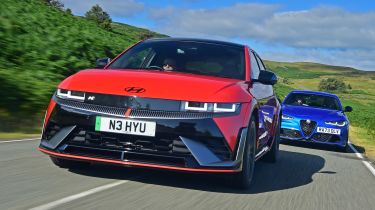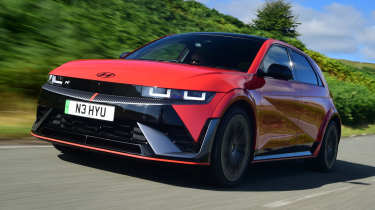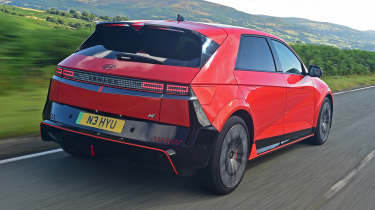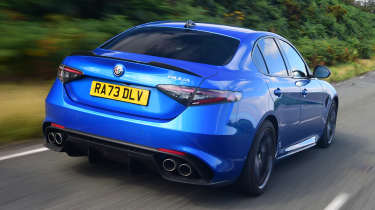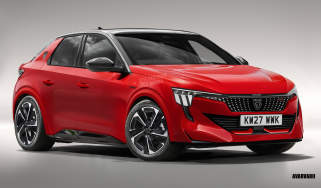Hyundai Ioniq 5 N vs Alfa Romeo Giulia Quadrifoglio: is EV or petrol more exciting?
Our 2024 Performance Car of the Year, Hyundai’s Ioniq 5 N EV, takes on the revamped Alfa Romeo Giulia Quadrifoglio
For a long time, performance electric cars have been one dimensional. They’re often so fast that all the meaning has been stripped from 0-62mph times; when you can walk into your local MG dealer and for just over £36,000 buy an MG 4 XPower that covers the benchmark dash in the same 3.7 seconds as an Audi R8 V10 RWD it’s easy to see why. Yet beyond the thrill of straight line speed, fun is often hard to come by. It’s one thing to bolt a shockingly powerful motor or two into a car; it’s another altogether to add chassis sophistication, precision and - most of all - genuine personality.
As it stands, just one electric car has proven to be a glorious exception: the Hyundai Ioniq 5 N. On our early encounters both abroad and on UK roads, it has proven that EVs can have the qualities that thrill and excite, and Hyundai has taken some unconventional steps that even enhance those qualities further.
To find out just how good it really is, we’ve brought along a benchmark from the internal combustion engine stable - and what a benchmark it is. The Alfa Romeo Giulia Quadrifolgio is one of the finest performance cars the brand has produced in decades, and it moves into 2024 with a series of small tweaks that aim to make it a better driver’s car than ever. If the Hyundai can offer even an ounce of the Giulia’s ability, it can be considered a huge success - but just how close can it get?
Hyundai Ioniq 5 N
| Model: | Hyundai Ioniq 5 N |
| Price: | £65,000 |
| Powertrain: | 2x e-motors, 84kWh battery, 641bhp |
| 0-62mph: | 3.4 seconds |
| Efficiency (WLTP): | 2.9 miles/kWh |
| Official range: | 278 miles |
| Annual VED: | £0 |
Hyundai’s N division has already proven that it is a performance arm that deserves to be taken very seriously. With the i30 N and i20 N, it proved that it can live with the very best hot hatch competition, but the Ioniq 5 N is a very different prospect - not least because it costs £65,000. But more than that, it is its electric powertrain that might prove to be too much for some, so Hyundai has pulled out all the stops to produce an epic driver’s car.
Testers' notes
- Hearing is a key sense when you’re driving quickly, with many drivers using engine revs – something that is missing from EVs. The Ioniq 5 N can be set to simulate an engine and an eight-speed dual clutch gearbox to compensate. It limits the torque through the ‘gears’ to give a power delivery and noise like a petrol car, and the fake gears are controlled via steering-wheel paddles. I’ll admit that before trying this I was prepared to hate it, but it works so well that you almost forget that you’re driving an EV at all.
- Beyond the typical drive modes, the Ioniq 5 N has a few extra settings to play with. The N Pedal is a system that disguises the car’s mass even further, with aggressive brake regeneration applied on corner entry to make turn-in even sharper. And N Torque Distribution allows the power balance between the axles to be chosen from one of 11 settings, while the N Drift Optimizer makes big skids even easier to achieve by balancing various drive systems to produce a consistent drift angle. It can even mimic a clutch kick to initiate a slide.
Alfa Romeo Giulia Quadrifoglio
| Model: | Alfa Romeo Giulia Quadrifoglio |
| Price: | £78,195 |
| Powertrain: | 2.9-litre V6 twin-turbocharged petrol, 513bhp |
| 0-62mph: | 3.9 seconds |
| Efficiency (WLTP): | 28.0mpg |
| Official range: | 357 miles |
| Annual VED: | £600 |
That the Giulia has been around for so long - it was first revealed over nine years ago - and still ranks among the best super saloons around is a huge credit to just how well Alfa Romeo nailed the basic Giorgio platform originally. Since then, it’s only needed small detail changes to keep things fresh; tweaked cabin materials and new LED matrix headlights are among the updates this time around. More importantly, the mechanicals haven’t been ignored either, which is why this model promises to be the best yet to drive.
Testers' notes
- It’s often said that the Giulia Quadrifoglio has the feel of a four-door supercar, and thanks to the new differential, that’s more the case than ever before. If I had to pick the closest comparison, it would be the Maserati MC20. Both feel delightfully old-school, with quick steering, agile handling and enough give in the suspension to make them work so well on UK roads. Disable the traction control, and both their throttle pedals deserve respect. It’s easy to light up those rear tyres, yet the cars are still so controllable.
- It may seem a little facile to claim that paint colours are important with such poised driver’s cars as these, but a great hue can really make or break a design. These models have fabulous choices that are perfectly suited to their opposing characters. The Alfa’s six options are classy; Etna Red, Montreal Green and this car’s Misano Blue are all stunning in the metal. The Hyundai’s are bolder and more outlandish; among them are its signature Performance Blue (available in gloss and matt finishes), and the lively Soultronic Orange.
Head-to-head
Tech highlights
Few cars released this year or next will be able to match the Ioniq 5 N’s comprehensive chassis and drivetrain features. High-tech features like a customisable torque distribution and a simulated eight-speed gearbox sit alongside more traditional upgrades like extra chassis welding and a reinforced steering rack. Beside the Hyundai, the Giulia seems remarkably simple in its approach; new for 2024 are retuned adaptive dampers and a thicker, stiffer rear anti-roll bar - both inspired by the hardcore Giulia GTA.
Powertrain
At 287bhp and 309bhp per tonne for the Ioniq 5 N and Giulia Quadrofiglio respectively, the similar power-to-weight ratios hid just how radically different these two cars approach the performance car formula. The old school Alfa gets an (uprated for 2024) 2.9-litre twin-turbocharged V6 engine sending all of its 513bhp to the rear wheels. The Hyundai gets 641bhp from its two-motor setup for four-wheel drive. That results in a 0-62mph time of just 3.4 seconds, beating the Alfa by 0.5 seconds.
On the road
Despite the two radically different approaches of these two cars, they have more similarities than you might think. Both are spectacularly good to drive, and it's possible to draw parallels between their balance, their adjustability and - despite their significant power outputs and weights, a surprising amount of delicacy. There are areas where the Hyundai’s mass is telling - under brakes and on turn-in in particular - but it compensates with phenomenal traction and staggering body control.
Weight
The Ioniq 5 N weighs 2.2 tonnes, but somehow Hyundai’s engineers have made it behave like a car that weighs almost half a tonne less. We say ‘almost’ because the Giulia reveals its superior direction changes and extra prowess under hard braking. That aside, both possess fabulous balance and poise - but the Hyundai extra grip shows its quality at even higher limits. The Ioniq also possesses a more natural weight to its steering, too.
Price and running
The 5 N isn’t very efficient by EV standards - we struggled to reach 3.0mi/kWh - but the electric powertrain makes it cheaper to run than the Alfa, even when it hits its (achievable) official 28.0mpg figure. Charge on a home electricity tariff at the current energy price cap of 22.4p/kWh and the Hyundai costs £771 per 10,000 miles, while the Alfa costs £2,310. That’s standard fuel, too - not the Super Unleaded that high performance cars prefer.
Practicality
This pair boast an identical 480 litres of boot space, but that’s where the similarities end in the practicality stakes. That aside, the larger Hyundai is by far the more roomy. Even that boot is more easily usable thanks to its square shape and hatchback boot opening, but it’s passengers in the back that will appreciate the huge rear knee room, wide rear bench and flat floor more than anything else - especially compared to the snug Alfa.
Verdict
First place: Hyundai Ioniq 5 N
It’s easy to find an EV with the straight line speed to blow away even the fastest petrol-powered super saloons, but it takes something incredibly special indeed to beat one of the best four-door drivers cars around. But that is exactly what Hyundai has achieved with the Ioniq 5 N. It’s insanely quick across the ground, but has the delicacy to match - and often beat - the Alfa for feel. Look beyond the badge and consider its better tech, superior practicality and lower price, and Hyundai has created a performance car that has beaten one of the very best around.
Second place: Alfa Romeo Giulia Quadrifoglio
There are some people reading this who, regardless of the outcome, would only ever have chosen the Alfa. And that’s fine, because those people are in for a massive treat. Small updates have cemented the Giulia Quadrofiglio’s strengths of performance and handling, and thrown a little more modern tech into the mix. Its four-door supercar feeling remains intact, and there aren’t many cars available at any price that offer so much character backed up by so much talent. If the Hyundai is an exciting glimpse at the performance car future, then the Alfa proves that some of the present qualities will be very hard to beat.
Prices and specs
| Our choice | Hyundai Ioniq 5 N | Alfa Romeo Giulia Quadrifoglio |
| Price from/price of our choice | £65,000/£65,000 | £78,195/£78,195 |
| POWERTRAIN AND PERFORMANCE | ||
| Powertrain | 2x e-motors | V6/2,891cc |
| Power | 641bhp | 513bhp @ 6,500rpm |
| Torque | 740Nm | 600Nm @ 2,500rpm |
| Transmission | Single-speed/4wd | Eight-speed auto/rwd |
| 0-62mph/top speed | 3.4 secs/161mph | 3.9 secs/191mph |
| Fuel tank/battery capacity | N/A/84kWh | 58 litres/N/A |
| Efficiency (WLTP) | 2.9 miles/kWh | 28.0mpg |
| Range | 278 miles | 357 miles |
| DIMENSIONS | ||
| Length/wheelbase | 4,715/3,000mm | 4,639/2,820mm |
| Width/height | 1,940/1,585mm | 1,860/1,433mm |
| Boot space (seats up/down) | 480/1,585 litres | 480 litres/N/A |
| Kerb weight | 2,235kg | 1,660kg |
| Power-to-weight ratio | 287bhp/tonne | 309bhp/tonne |
| Turning circle | 12.4 metres | 10.8 metres |
| COSTS/OWNERSHIP | ||
| Residual value (after 3yrs/36k miles) | £35,152/54.08% | £35,266/45.10% |
| Depreciation | £29,848 | £42,929 |
| Insurance group/AA.com quote/VED | 49/£515/£0 | 46/£1,657/£600 |
| Three-year service cost | £302 | £399 |
| CO2/Benefit-in-Kind (BiK) band | 0g/km/2% | 229g/km/37% |
| Annual tax liability std/higher rate | £260/£520 | £5,705/£11,411 |
| Fuel cost (10,000 miles) | £771 | £2,581 |
| Basic warranty/recovery | 5yrs (unlimited)/2yrs | 3yrs (unlimited)/1yr |
| Driver Power manufacturer position | 17th | 13th |
| NCAP Adult/child/ped./assist/stars | 88/86/63/88/5 (2021) | N/A |
| EQUIPMENT | ||
| Metallic paint/wheel size | £700/21 inches | £700/19 inches |
| Parking sensors/camera | Front & rear/360-degree | Front & rear/yes |
| Spare wheel/Isofix points | Repair kit/two | Repair kit/two |
| Keyless entry & go/powered tailgate | Yes/yes | Yes/yes |
| Leather/heated seats | No/yes | Yes/yes |
| Screen size/digital dashboard | 12.3 inches/yes | 8.8 inches/yes |
| Climate control/panoramic sunroof | Yes/£1,250 | Yes/no |
| USBs/wireless charging | Five/yes | Two/yes |
| Wireless CarPlay/Android Auto | Yes/yes | Yes/yes |
| Blind spot warning/head up display | Yes/yes | Yes/No |
| Adaptive cruise/steering assist | Yes/yes | Yes/£1,100 |
What would we choose
Hyundai Ioniq 5 N
The Ioniq 5 N is incredibly well equipped, so the only option is the £1,250 ‘Vision Roof’. The panoramic glass opening lets much more light into the cabin when you want it, and an electric blind keeps it out when you don’t.
Alfa Romeo Giulia Quadrifoglio
At £3,250, the Sparco Carbonshell front seats are a pricey extra, but they are superbly supportive and look fantastic. The £1,100 Driver Assistance pack is worth considering if you drive many motorway miles.

